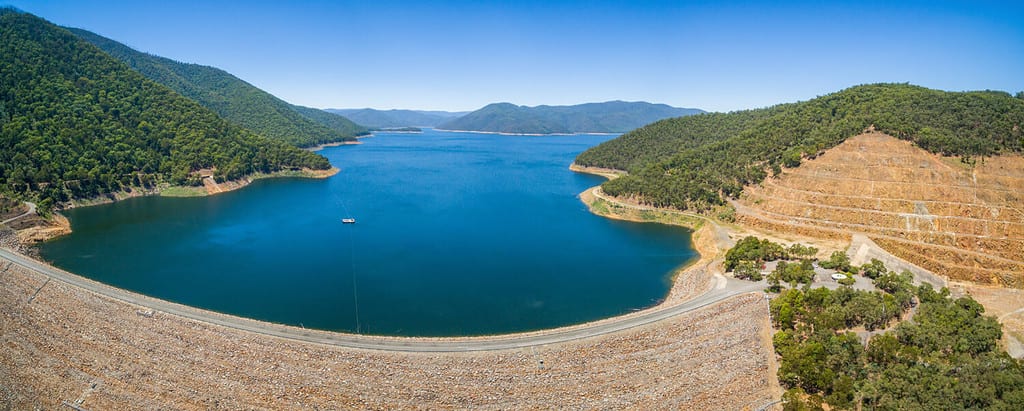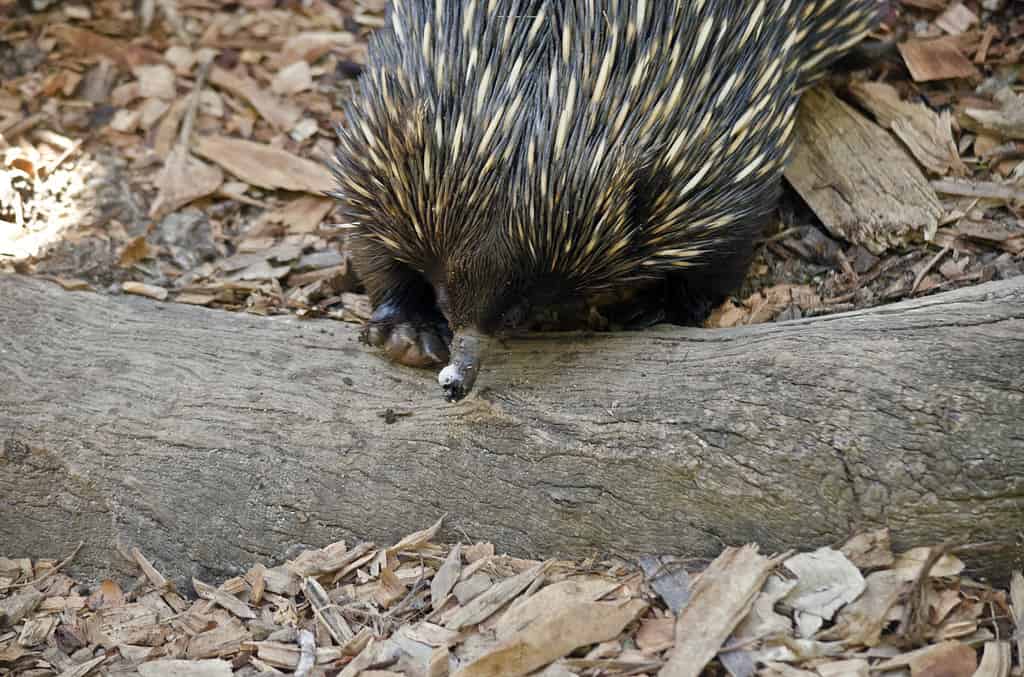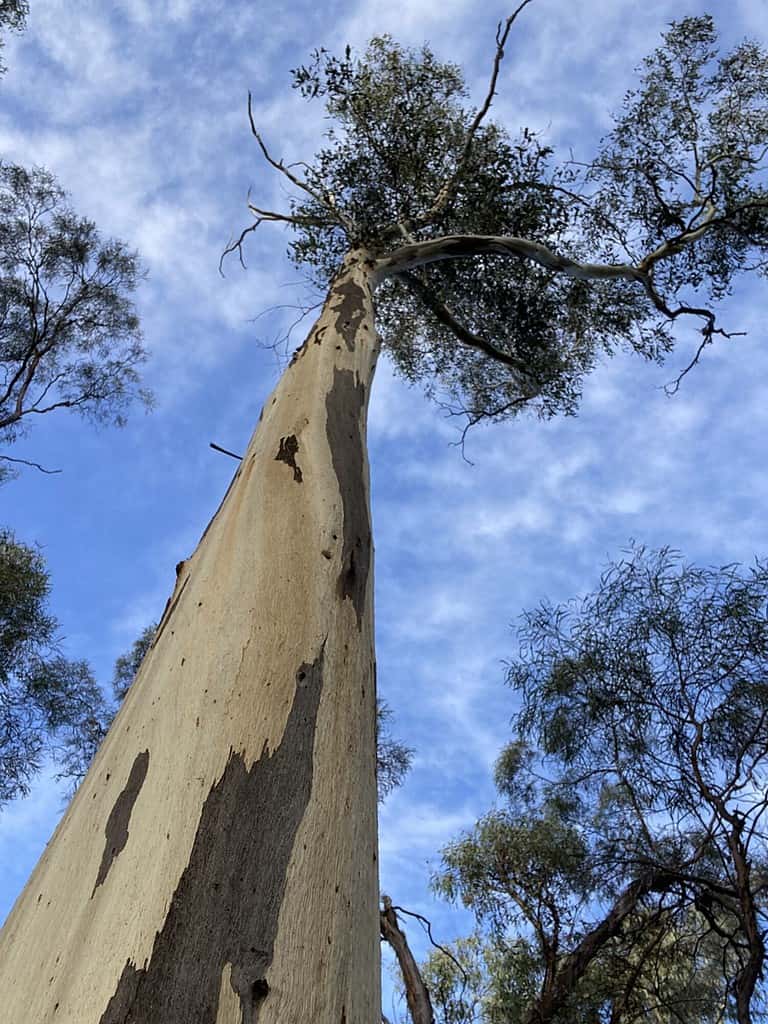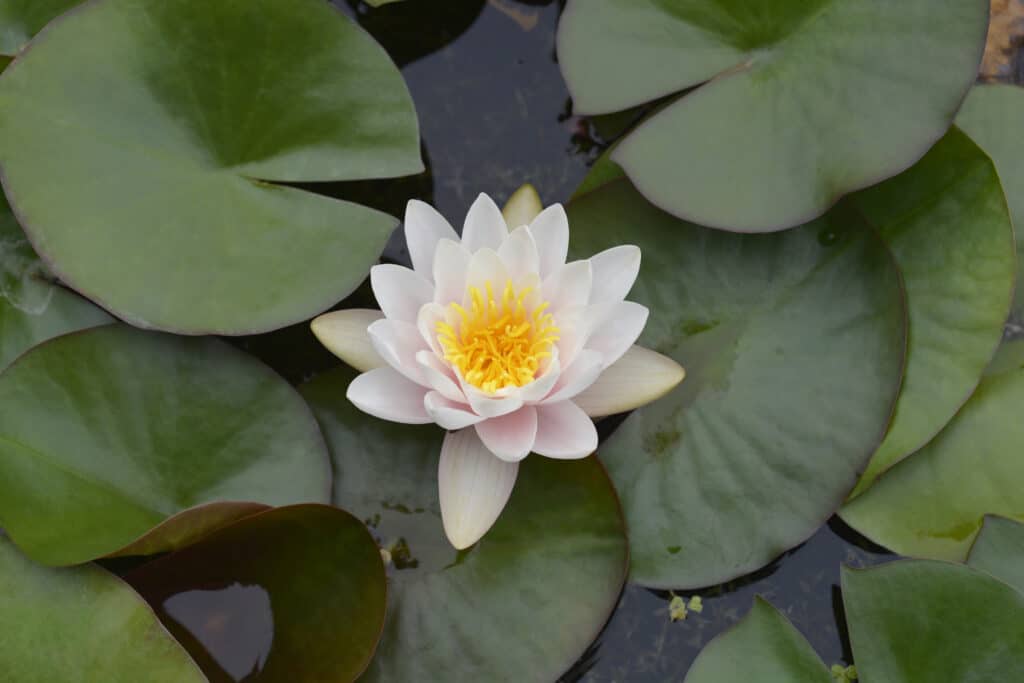We depend on the availability of clean, potable water for a wide range of essential tasks. From drinking and bathing to cooking and cleaning, we use water every day. Yet, we often take for granted the complex network of reservoirs and waterways working behind the scenes to ensure this vital resource reaches our homes. And so it goes with Dartmouth Dam, the tallest dam in Victoria. Dartmouth Dam impounds Dartmouth Lake. Dartmouth Lake is a principal source of water for the Northeastern region of Victoria. The dam provides for water storage, irrigation, flood control, and hydroelectric power generation. So, lace up your hiking boots, and grab your fishing pole as we strike out on a grand adventure to discover the largest dam in Victoria.

Dartmouth Lake is a principal source of water for the Northeastern region of Victoria, Australia.
©Greg Brave/Shutterstock.com
Discover the Tallest Dam in Victoria: Construction
Dartmouth Dam is located on the Mitta Mitta River, which is a tributary of the Murray River. The dam and resulting reservoir are in the Northeastern part of the state of Victoria. Victoria is located in Southeastern Australia. It sits between New South Whales to the North and South Australia to the West. Dartmouth Dam is the largest reservoir in Victoria. It plays a critical role in water storage, irrigation, and hydroelectric power generation for the region. Construction on the dam commenced in 1973 and was completed in 1979. Dartmouth Dam is a rock-fill embankment dam. The wall is 590 feet (180 m) high and is comprised of:
- 353 million feet3 (10.5 million m3) of rock
- 28 million feet3 (0.8 million m3) crushed quarried rock
- 7 million feet3 (2.8 million m3) of earth for the core.
Dartmouth Dam is not only the largest rock-fill embankment dam in Australia it is also the largest rock-fill embankment dam in the Southern Hemisphere! The dam’s uncontrolled shute spillway is located at the site where the stone was quarried to construct the wall. Dartmouth Lake rarely exceeds its storage capacity of 498 million feet3 (14.1 million m3). However, on the rare occasions when the dam doth spill over, it is quite a sight to behold. Water cascading over multiple rock ledges adds a new dimension to the reservoir. Dartmouth Dam spilled over in 2022, attracting up to 300 visitors daily. It was the first spill at the dam since 1996.
Power Station and Irrigation
The dam features a hydroelectric power station. opened in 1981, which generates electricity. The reservoir releases water to generate power, while the station contributes to Victoria’s energy supply. Featuring a Francis turbine, the Dartmouth power station can generate 180 megawatts (240,000 hp). It is the largest of its kind in Australia. Dartmouth Dam and its associated water resources are crucial for supporting agriculture in the region, particularly for irrigation. Farmers in the Mitta Mitta Valley and surrounding areas rely on water from the river to grow crops and raise livestock.
Displacement
The construction of Dartmouth Dam and the creation of Lake Dartmouth led to the flooding of towns and communities in the Mitta Mitta River valley. The process of inundating areas to create a reservoir often involves the relocation or submersion of existing towns and settlements. Before the reservoir was filled, the town after which the dam is named, Dartmouth, was relocated to higher ground. Lake Dartmouth now covers the original site, keeping its secrets safe for eternity.

Dartmouth Lake rarely exceeds its storage capacity of 498 million feet
3(14.1 million m
3).
©Paul Feikema/iStock via Getty Images
Discover the Tallest Dam in Victoria: Wildlife
The area around Lake Dartmouth is a popular spot for birdwatching. Ducks, swans, and herons are about as well as raptors like eagles, hawks, and falcons. The laughter of Kookaburras, the largest species of kingfisher can often be heard around the lake. Gray fantails and white-faced herons are also prevalent. Lake Dartmouth is home to various fish species for recreational fishing. Common species in the reservoir include brown and rainbow trout and the Macquarie perch. Eastern grey kangaroos and wallabies live in the bushland and open areas surrounding the reservoir.
Wombats, known for their burrowing habits, are also present in the region. Various species of possums and gliders, such as the common ringtail possum, sugar glider, and greater glider, inhabit the forests and woodlands.

Kookaburras, the largest species of kingfisher, can often be heard laughing around the lake.
©Russ Heinl/Shutterstock.com
The area is home to a variety of reptiles, including Eastern blue-tongued lizards, snakes, and skinks.
An array of insects and arachnids call the Lake Dartmouth region home.
In some of the waterways around the area, particularly along the Mitta Mitta River, you may have the opportunity to spot the elusive platypus, a unique monotreme species. Another type of monotreme, the Echidna, lives in the forests and bushland. Various frog species, including the common Eastern froglet and the spotted marsh frog, call the area home.

Echidnas are another type of monotreme sometimes seen in the forests and bushland.
©Susan Flashman/Shutterstock.com
Discover the Tallest Dam in Victoria: Plantlife
The area around Dartmouth Dam is characterized by a diverse range of flora due to its location in the alpine region and the surrounding landscapes. The region is home to various species of eucalyptus trees, including mountain gum (Eucalyptus dalrympleana), snow gum (Eucalyptus pauciflora), and candlebark gum (Eucalyptus rubida). These trees are well-adapted to the alpine environment and are a dominant feature of the landscape.

The region is home to various species of eucalyptus trees.
©Kathleen Exell/Shutterstock.com
Various species of acacia (Acacia myrtaceae), commonly known as wattles, can be found in the area. Acacias are known for their bright yellow flowers and often grow along riverbanks and in open woodlands. Due to the higher elevation of the region, you can find a variety of alpine plants and wildflowers, including species like alpine buttercups, billy buttons, and alpine daisies. These plants add vibrant colors to the landscape during the blooming season. The dam’s shorelines and surrounding areas are often covered with native grasses and sedges that play a crucial role in stabilizing the soil and supporting local wildlife.
Along the Mitta Mitta River and its tributaries, you can find vegetation such as river red gum (Eucalyptus camaldulensis) and various types of reeds. In the shaded and wet areas near the dam are fern species like the common bracken fern (Pteridium esculentum). Shrubs like the snow tussock (Poa fawcettiae), and heath tea tree (Leptospermum myrsinoides) are common. In the reservoir itself, aquatic plants grow especially in shallow areas. These include species like water lilies.

In the reservoir itself, aquatic plants grow especially in shallow areas. These include species like water lilies.
©iStock.com/Nahhan
Discover the Tallest Dam in Victoria: Recreation
Lake Dartmouth is a popular destination for those seeking outdoor adventures and relaxation. The reservoir and its surrounding areas offer various outdoor activities. Lake Dartmouth is known for its fishing opportunities. Anglers visit the reservoir to catch a variety of fish species, including trout, Murray cod, and golden perch. Boating, kayaking, and canoeing are popular pastimes on Lake Dartmouth.
There are camping areas around the lake, providing a place for visitors to set up tents, or campers. At least two campsites are accessible only by boat. The reservoir offers picnic facilities, making it a great spot for families and groups to have outdoor meals and enjoy the scenery. Area trails provide opportunities for hikers and nature enthusiasts to explore the area. The Eskdale to Dartmouth Dam Ride is a 30-mile (50 km) point-to-point bike trail. It is considered challenging. The reservoir’s location amid the stunning landscapes of Northeastern Victoria makes it a destination for landscape photographers.
The photo featured at the top of this post is © Stephen Edmonds, CC BY-SA 3.0 – License / Original
Thank you for reading! Have some feedback for us? Contact the AZ Animals editorial team.






